With the digital world constantly growing, almost every single thing we do is “measured” in data. But, the data on its own is useless. Considering data comes from countless sources and locations, it needs to be integrated correctly to be effective. Why?
Simple—in our current economy, data teams must not only generate various amounts of data but also properly integrate it into different sources. Most modern businesses rely heavily on data to manage and run their day-to-day operations. Whether it’s sales or marketing ops, every department and team in an organization depends on data.
With Slack, Salesforce, HubSpot, and Jira becoming star players in today’s operation sphere, shaping our way of work, finding integration tools that are compatible with these systems is now an absolute necessity. It makes daily operations that much more effortless and work that much more efficient.
Data integration tools can be used to streamline the process of collecting data from different kinds of sources and provide valuable business insights. Data integration ultimately leads to better customer relationships, improved competitiveness, decision-making, and quality of work—everything you need to scale a successful business.
With all of this in mind, it is clear that data integration tools play a critical role in helping organizations become more data-driven. To make your life easier, in this article, we’ve narrowed down the best data integration tools that can help your business function better than ever in 2024.
What Are Data Integration Tools?
Data integration tools are software applications that aggregate data from various sources and consolidate it into a single, unified view. These tools are essential for creating a cohesive data environment, allowing for efficient data management and analysis.
They can handle tasks such as:
Combining Data: Merging data from different systems into one cohesive dataset.
Transforming Data: Standardizing and formatting data for consistency and usability.
Synchronizing Data: Ensuring that data is up-to-date and consistent across all platforms.
Loading Data: Transferring data into target systems for analysis and operational use.
Data integration refers to the process of collecting data from multiple sources and consolidating it in one place—a data warehouse or a data lake, where it can be analyzed and translated. Its goal is to make data readable and easily accessible to users.
To achieve this, data integration tools use data pipelines. A data pipeline is a process used to move data from one source to another. The data pipeline process involves several steps:
Intake: Extracting the data from one source and placing it in a storage layer. Typically, the initial intake goes into a data lake and later in the process into a data warehouse. This is done to prep an efficient data load to a warehouse or simply to create a replica of the raw data that can serve other use cases outside of a warehouse such as machine learning workloads.
Data Transformation: Transforming and processing that data, i.e., converting the data from one format or structure into a different one. It is done so that the raw data being transferred matches the structure or format of the data target it will be transferred into. Most importantly, transformed data is ready for analysis and consumption by other tools such as BI tools.
Data quality: Cleansing the data and applying quality rules, i.e., fixing or completely removing any bits of data that are either corrupted, incomplete, duplicated or have the incorrect format. This step may (and should) occur throughout the other two steps mentioned above.
4 Types of Data Integration Tools
There are four main types of data integration software. When it comes to different data integration tools, it’s important to do the proper research. There’s no one size fits all solution, each software offers different capabilities. To help guide you, we’ve done some of the research for you.
On-Premise Data Integration Tools
On-premise data refers to data that can be found on any local servers, devices, and computers. Essentially, it’s the very hardware that a business has purchased to store company-sensitive data. Often, this data can only be accessed through a private cloud server or a local network with custom connectors set up for batch loading. Similarly to the data, tools under this category, run locally and require manual installation and upgrades with every new version or bug fix.
Cloud-Based Data Integration Tools
Cloud-based data warehouses are used by integration-oriented and iSaaS platforms to integrate data onto them from foreign sources such as third-party apps and cloud-hosted databases. Businesses that use these tools prefer to use cloud computing services for data integration and management.
Open-Source Data Integration Tools
These tools are considered among the most cost-effective from a licensing perspective because they come with pre-built connectors and modules, which, on their own, can be very expensive. Businesses with experienced teams with a lot of technical knowledge or IT professionals are the target clients for these integration platforms.
Proprietary Data Integration Tools
Proprietary DI tools are similar to open-source tools, but their main difference is their price. These software tools are a closed-source code built into a complete product whose license is then sold to another company or user. The advantage of this is that they are custom-made for their client’s company.
10 Best Data Integration Tools
Without integration tools, data cannot be accessed. This leaves businesses with no choice but to access the data manually, resulting in data silos, poor data quality, wasted time on resources, and many other mistakes. In fact, data integration software and tools ensure that day-to-day work is fast and efficient.
The market is flooded with options, so we’ve done the heavy lifting for you and compiled a list of the top 10 data integration tools to improve your business operations in 2024.
1. Informatica Power Center

Informatica is a software development company that is among the industry veterans known for developing integration tools. Their Power Center tool is used by many medium and large-sized businesses to provide them with not just data integration but also data management, cleansing, cloud integration, and more.
Informatica also acts as a connector for many heterogeneous sources and works well with legacy data. Regardless of how user-friendly its interface is, it’s still best handled by data engineers that went through dedicated training. Moreover, businesses that want to process large amounts of data will require computing equipment and software that is strong enough to handle this ETL tool.
Pricing
Basic plan starts at $2,000 a month.
- Feature-rich for Enterprises
- Connects to plenty of databases
- No MacOS compatibility
- Onboarding is slow
- Requires a lot of memory
2. Rivery
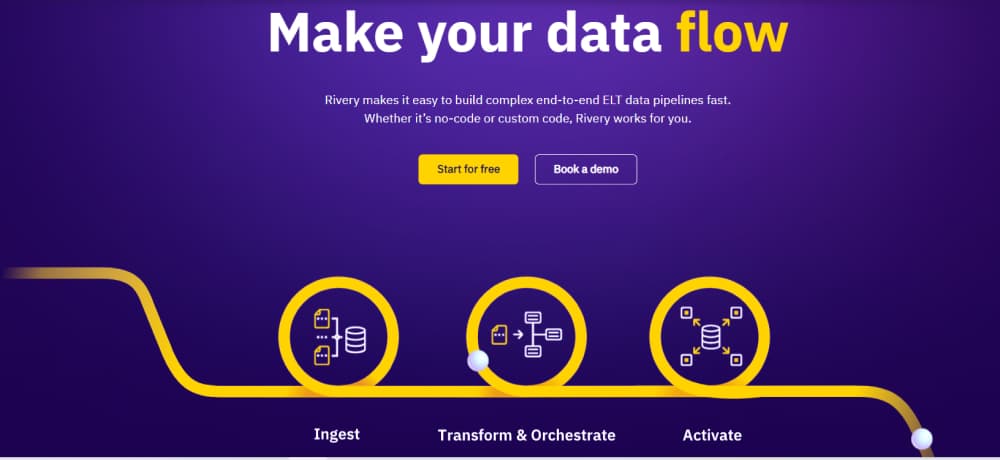
Rivery is a SaaS ELT platform that helps businesses of all sizes easily build end-to-end data pipelines faster. Rivery frees up data teams from tedious data management tasks, helping in every step of the data operations process. Right from data ingestion, and data transformation, to data orchestration and data activation (Reverse ETL). >> Learn about our Reverse ETL solution.
Rivery’s strength lies in enabling users to extract big data from virtually any API source and then integrate the data directly into a cloud data warehouse or lake.
Arguably two of its best features are the 200+ native connectors and predefined data model kits. Rivery’s easy-to-use connectors require zero code or API upkeep, making it so simple to extract data from anywhere and load it right into your target destination where you can transform the data however you like. It helps take a huge burden off data teams while saving money and time.
When it comes to Rivery’s support, the ratings say it all. G2 reviewers rave about Rivery’s award-winning customer service and ability to meet bespoke requests and demands.
As a custom and no-code data integration tool, Rivery is a flexible, agile, and easy-to-use platform that fits almost any kind of organization. Rivery is a smart choice for people looking for faster and more reliable data ingestion that is both functional and offers enterprise-level security.
You can try our free trial here.
Pricing
Rivery has a unique pricing model, charging per “RPU” or Rivery Pricing Unit. The monthly cost is the total sum of RPUs used during the month. There are 3 business plans:
- Starter: $0.75 per RPU
- Professional: $1.20 RPU
- Enterprise: Customizable (contact sales).
- Supports Python and SQL
- Over 200 pre-built connectors
- Custom connectors for any REST API
- Predefined data models
- Automated, end-to-end data pipelines
- Complete SaaS platform
- Cloud only with on-premises version
3. Talend
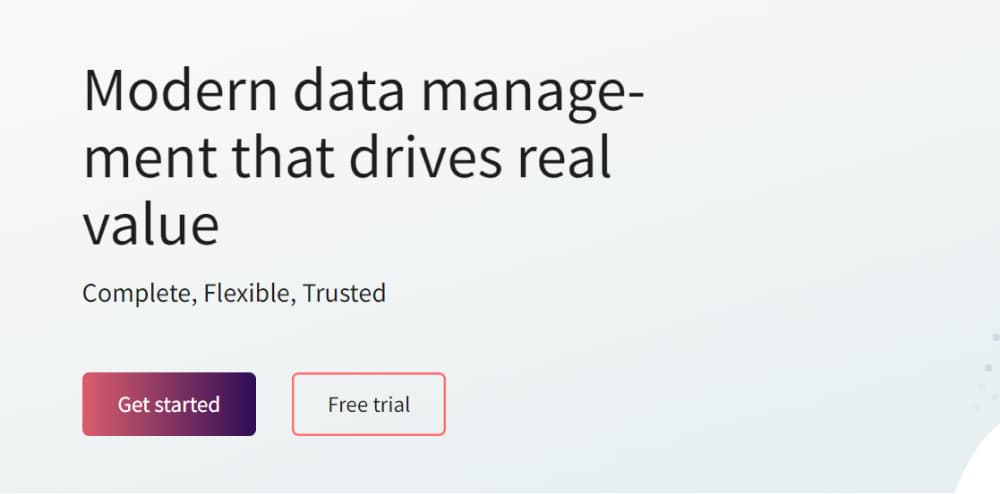
Talend is an ELT company that specializes in data integration and data management. Their main pride is that it’s open-source, making Talend an ideal place for their community to discuss issues or problems.
Their Open Studio product is ideal for businesses looking to optimize their cloud data integration experience. However, the platform doesn’t allow for continuous integration, the cataloging of data, or even data security. All of these features, and more, are available only in the paid version, which is quite expensive.
Pricing
Talend has 4 pricing plans with all prices available upon request.
- Open-sourced ETL tool with high security
- Lots of data quality features
- Can connect to various databases quickly and easily
- Solid free version with the chance to upgrade
- Steep learning curve
- Mainly used by professionals
- Not designed as a cloud platform to begin with It may consume more CPU and memory
4. Pentaho
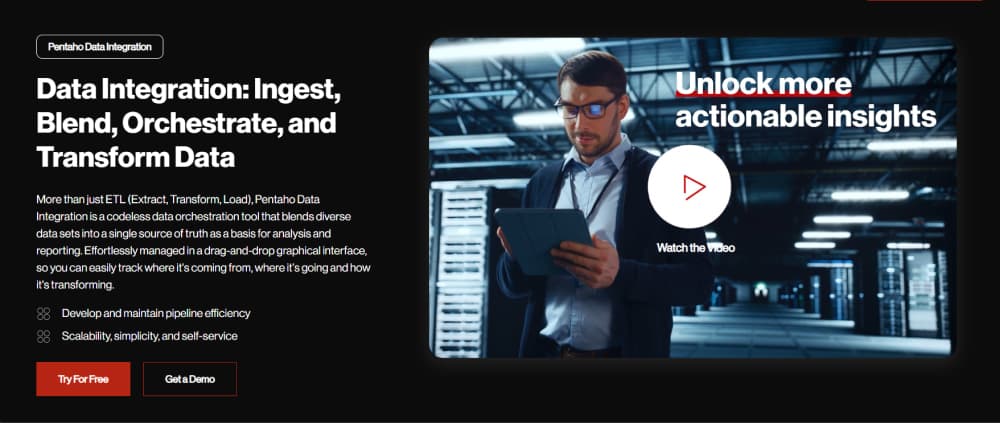
The Pentaho Data Integration, or PDI for short, is a data integration platform by Hitachi Vantara. Their goal is to provide businesses with ELT tools to gather, clean, store, and transform data. They are an established company allowing clients to transfer and format data into various data warehouses and formats.
One of their key features is that their clients can use ELT tools on an interface without needing to actually write any codes. The downside is that it misses some important features that most companies need, such as SaaS. Plus, previous knowledge is required even if you want to build the simplest pipeline.
Pricing
Starts at $100 per month for the freemium option.
- Easy-to-use tools for small data volumes
- Codeless community project
- No SaaS version
- Scalability issues with larger data volumes and difficulty to solve bug errors
5. Snaplogic
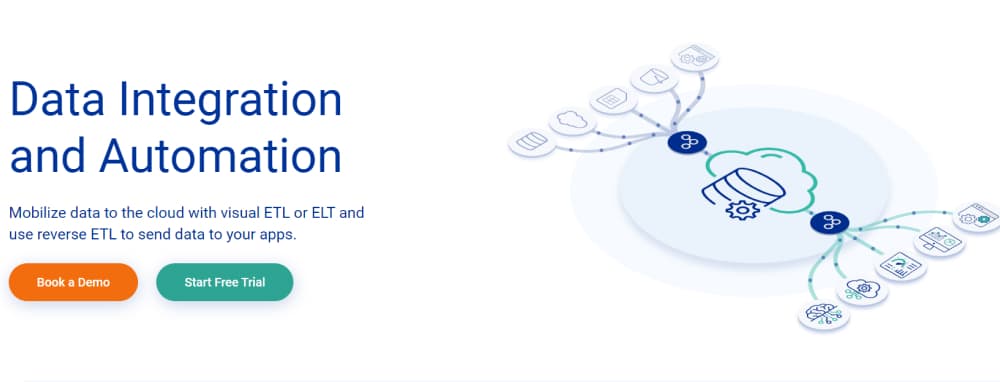
Snaplogic is an integration system, or iPaas, designed to assist enterprises by providing faster data integration. It comes with an AI assistant that aids its clients by integrating data between platforms and reporting on any error detected.
The platform comes with various tools that help keep track of progress and the state of any ELT-related process. This is further aided by Snaplogic’s relatively easy-to-use interface. It also comes with over 500 connectors, making it a solid choice for businesses and clients that don’t have extensive technical knowledge or experience.
One downside is that it doesn’t focus on SMEs, as all features are mostly tailored toward established businesses.
Pricing
Snaplogic offers flexible pricing options:
- Free Trial: Free.
- Base Pricing: Starts at $9,995 per year.
- Premium Features: Premium Snap Packs priced between $15,000 and $45,000 per pack.
- Customizable Options: Available on request.
- It has a list of good integrations
- Can process big data easily
- It’s mostly suited for larger businesses
- Troubleshooting is difficult
6. Segment
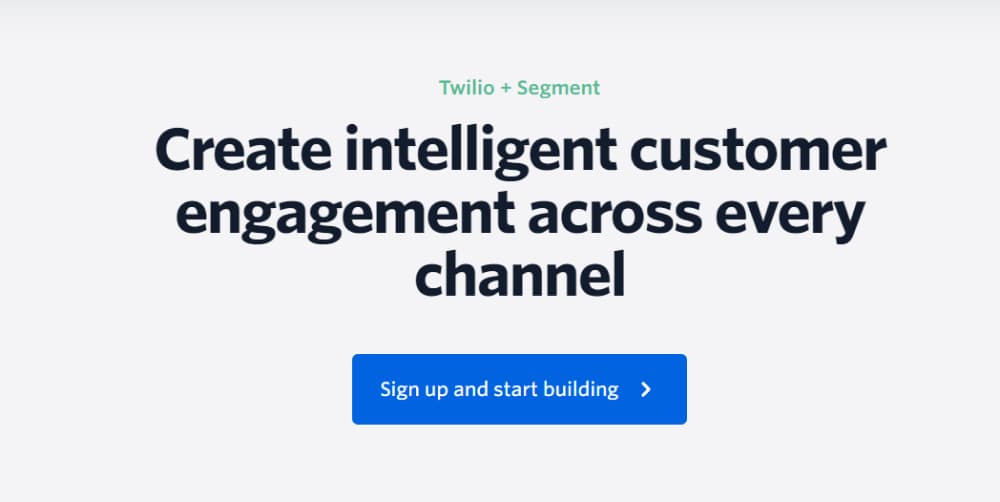
Twilio Segment can be used as a data integration tool for ingesting and processing data of various sizes. This is beneficial as it is a customer data platform that can be used to store all user data and deliver it to the appropriate data warehouses. Segment is compatible with over 200 technologies like Stripe, Google Analytics, and Adobe.
The platform can be for SaaS and cloud-based data services. Although it can handle larger amounts of data, it is particularly useful for smaller and medium-sized businesses. It is helpful for allowing companies to analyze user data better and establish data pipelines between different tools and apps.
A downside to this platform is that it’s not easy for beginners to use and may require more experienced users.
Pricing
Segment has 3 pricing plans:
- Free: $0.
- Team: $120/month.
- Business: Custom Pricing.
- Good for creating customer 360 views
- You can easily track events
- Not specifically designed for data integration and so lack necessary features
- Can be difficult for beginners to use
7. Hevo Data
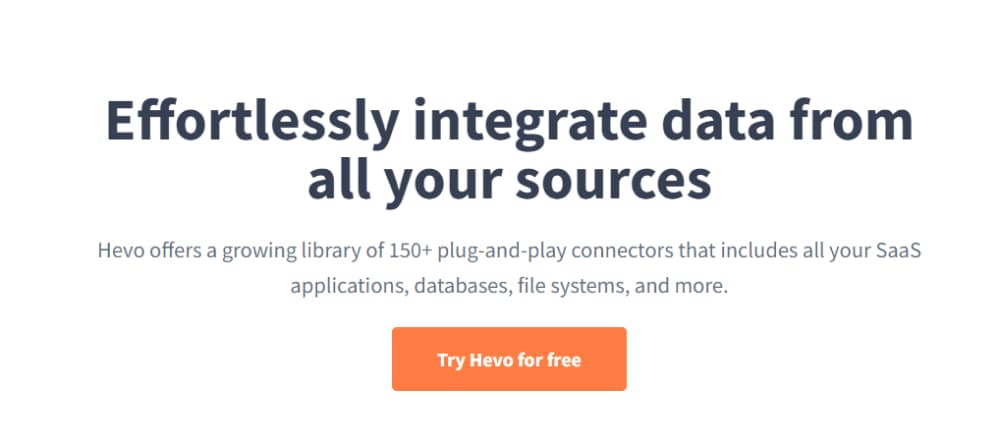
Hevo is a unified data platform with over 150 pre-built connectors. These include systems such as BigQuery and Redshift. The platform allows its clients to use it to monitor their workflow and fix any issue just as it occurs. Hevo Data is a data pipeline platform that can be used without any manual coding.
These features make the tool more suited for modern SaaS applications, cloud databases, and storage. While the platform offers better documentation than other tools, it is difficult for clients to schedule events for specific times. Hevo Data is compatible with all businesses, both small and large.
Pricing
Hevo Data has 3 pricing plans:
- Free: $0.
- Basic: $239.
- Enterprise: Custom pricing.
- Has 150+ pre-built connectors
- A no-code data integration platform
- Limited customization options
- Limited in how clients can organize and schedule events
8. Dataddo
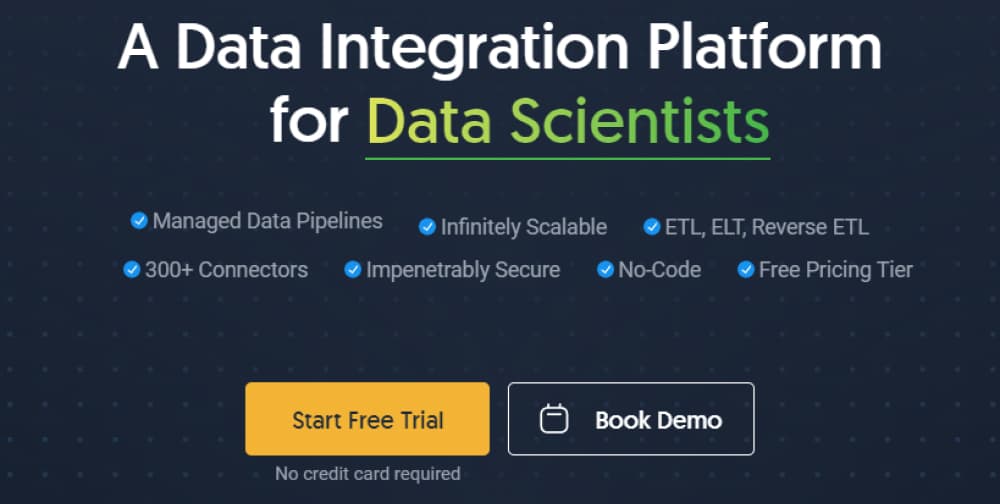
Dataddo is a cloud-based platform that comes with several key features. One of these features includes allowing fast data transfers between different warehouses and applications. This is further useful as the platform has over 200 pre-built connectors. Although Dataddo has its own unified API, users can build and implement their products alongside it.
With this platform, you have several options for transferring and integrating data using Dataddo’s ETL and reverse ETL tools. The platform is also scalable and, as such, can be used by either small or large enterprises. Note, however, that making a custom data source can be a slow process.
Pricing
Dataddo has 4 pricing plans:
- Free: $0.
- Data to Dashboards: $99.00 / mo.
- Data Anywhere: $99.00 / mo.
- Headless Data Integration: Custom Pricing.
- Comes with many options for data integration
- The platform is easy-to-use
- Building custom data sources can be time-consuming
- Subscriptions are hard to cancel
9. Fivetran
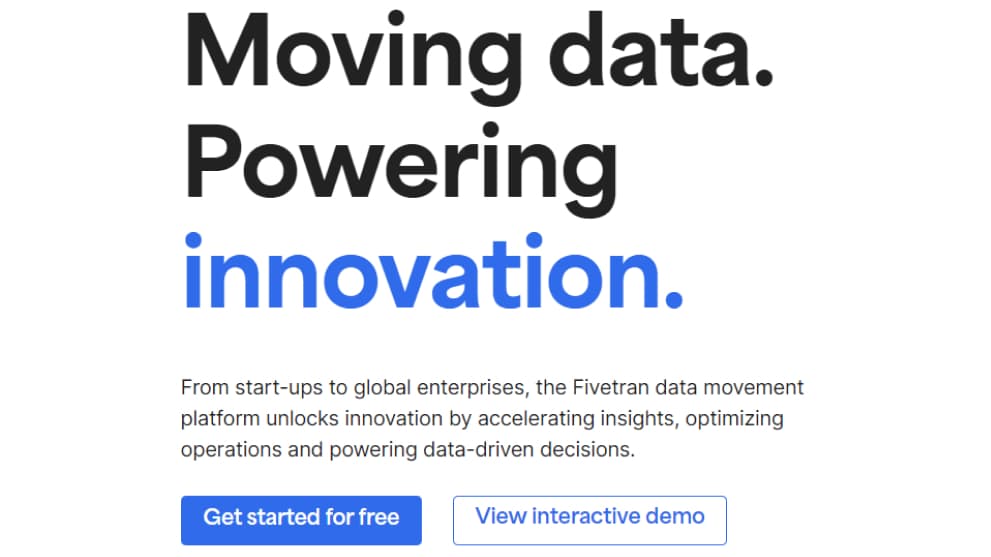
Fivetran is a platform that offers users a variety of tools useful for data extraction and integration. The platform supports many connectors, which makes it easier for clients to collect and store large quantities of data.
Fivetran is compatible with SaaS and Cloud-based applications. It has an API that can be configured to suit the client’s needs and has several management features that let you better organize and edit users, groups, and connectors. One downside is that, because of its pricing, it may be better suited to larger businesses and enterprises.
Pricing
Hvr has 4 pricing plans:
- Free: $0.
- Starter: Pay as you use.
- Standard: Pay as you use.
- Enterprise: Custom pricing.
- Comes with a configurable API
- Automatic data migration makes for a faster workflow
- Only handles extraction and loading with predefined transformation. Any other transformations require 3rd party tools.
- Can be difficult to monitor data or receive alerts on time
10. Oracle Data Integrator
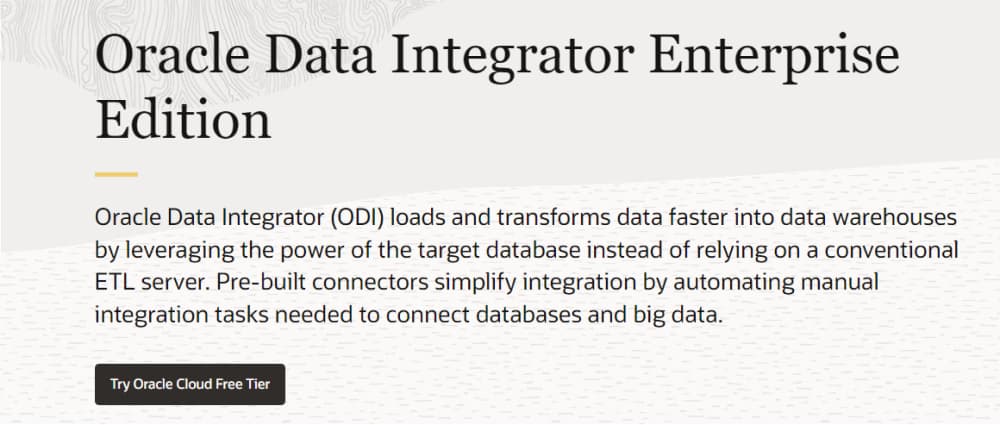
The Oracle platform has various tools and systems that offer users extensive scalability through the Oracle Database, GoldenGate, Fusion Middleware, Big Data Appliance, and Exadata. It comes with seamless data integration for both SaaS and SOA-enabled data services.
Among this integration software’s many functions, the most noteworthy is its high-performance architecture; this makes it fully capable of integrating large volumes of data without sacrificing performance value. Moreover, Oracle DI can connect and work with its own applications and other third-party platforms.
As this tool aids in reducing maintenance costs, it’s suitable for businesses that look for more cost-effective data management and integration solutions.
Pricing
Available upon request.
- Many data transformation options
- Works well with big data
- It may be too complex for beginners to understand
- Can be costly
Why Should You Choose Rivery as Your Data Integration Tool?
Rivery has a selection of products and services that are easy to navigate and use, making it one of the most advanced data pipelines. Data ingestion is completed quickly, and the entire data integration process can be automated, meaning there is no need for manual work with Rivery’s user-friendly UI. Its flexibility and scalability make it the absolute best choice for businesses of all sizes.
Sign up for a free trial or use the pre-built data workflow templates available!
Minimize the firefighting. Maximize ROI on pipelines.





